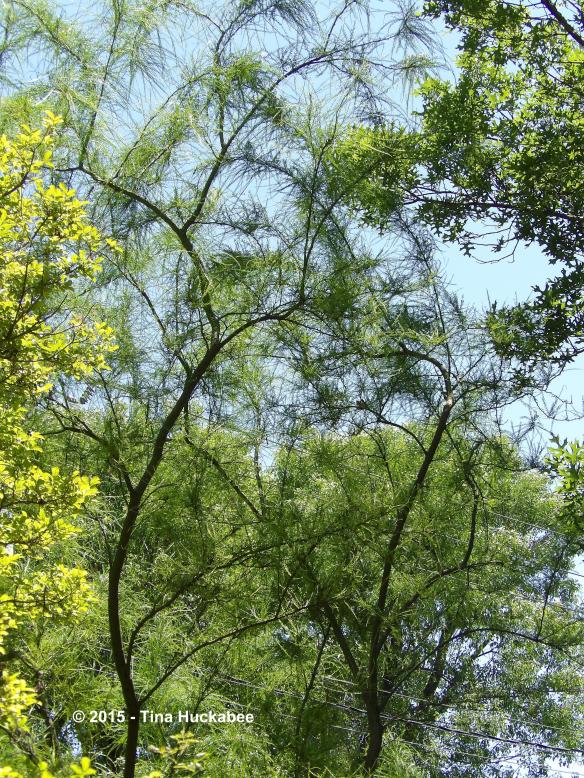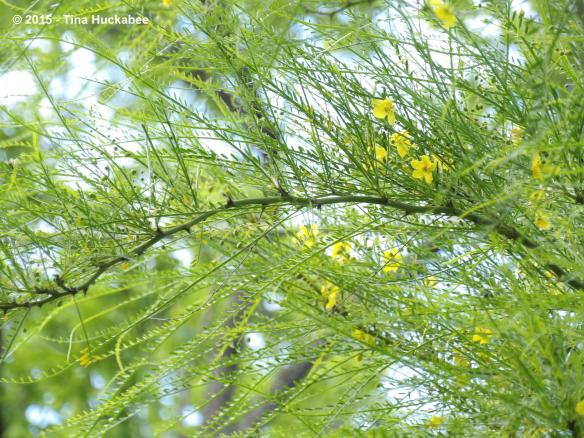Thanking Lucy at Loose and Leafy for hosting the fun Tree Following meme, we’re checking in today on our chosen trees. My Retama, Parkinsonia aculeata, leafed-out fully this past month, providing a respite for this Red-winged Blackbird during his visit to my garden.
No longer just a display of green bones that are trunk and limbs,
…the tiny, flat leaflets formed along the paired stalks and sport a spring green that is most welcome in my garden.
The fine foliage is lacy against the sky.
The tree fills in a space between the backdrop of neighbors’ trees and my own Shumard Oak, Quercus shumardii. Those blasted electric lines traverse the foliage.
I guess I shouldn’t complain about the lines though, should I? After all, I couldn’t very well write about Retama and hit “send” without them.
The Retama is lovely in any light–I’m so glad I have one in my garden and that I chose it to follow this year.
In the past week, look what’s happened!
Just a few for now and they are clustered together in the topmost foliage, but soon the flowers will appear all over the tree and pollinators of all stripes and wings will visit. It’s been windy here recently, so good photos are tricky.
As this week is National Wildflower Week in the U.S. I think it’s appropriate to laud the Retama’s beauty and appropriateness in its native range. Retama is a native small tree/shrub to Texas and a bunch of other places throughout North and South America. It is an arid climate plant, thriving in dry, hot conditions and a valuable plant in many ways–medicinally, and scientifically, as well as being important for erosion control and soil reclamation.
But the Retama, P. aculeata, has also proven invasive and a problem plant for many areas where it has been introduced. Australia has banned it entirely because it’s become such a noxious weed. Retama escapes from controlled cultivation, probably by birds which spread the seeds, and becomes weedy in natural ranges. 
I think this is a good reminder that where a plant is native, there are controls and conditions to keep the plant “in check.” The Retama in my garden belongs here, in my garden. It is a native plant to the region in which I live and garden, and a fine addition for its beauty, its water-wise characteristics, and its ability to thrive in the hot summers. Additionally, it’s also a great wildlife plant. But in places where it is introduced and has invaded, problems arise. Retama spreads and grows rapidly, forming thickets and native plants cannot complete, thus the Retama is responsible for declining flora diversity. It causes problems with livestock (because of its thorns) and spreads profusely when there is plenty of soil moisture.
Because we love of plants, gardeners should be cognizant of how our plant choices impact our home region. When we can do, we should choose native plants and wildflowers to help beautify our world and assist wildlife, but we should also encourage and lobby nursery businesses to supply native plants so that we have choices. When we totally fall in love with a non-native plant and must have it–and that’s happened to all of us–we should learn about the plant and take care that it isn’t invasive and won’t harm our local environment.
Thanking Lucy again for Tree Following–pop over and learn about trees from all over the world. Enjoy!













A good (and timely) reminder to take responsibility for our plant choices. There are often strong arguments to be made against using non-natives from other similar climate zones. I’m currently fighting the spread of a couple of invasive plants that were originally sold as “well adapted for our area” at a reputable nursery. It seems lots of us were a bit behind the curve with realizing how dangerous a game it can be to take a plant out of its natural system of checks and balances!
That said, your retama is the right tree in the right place. Absolutely lovely with that feathery foliage and while tricky to photograph, it must be a joy to behold in the breeze!
LikeLike
We’ve all bought THAT plant that turned into a botanical bully out in the world. It’s hard not to when nurseries will sell just about anything. Maybe as more folks take up the mantle of installing gardens, instead of turf, the practicality of buying local, native plants will take hold. Fingers crossed.
That Retama, it’s a joy all the time!
LikeLike
Wise words Tina about choosing plants carefully. Hopefully we are learning the past lessons.
LikeLike
Thanks, Julie I hope so too.
LikeLike
I loved reading more about your Retama, Tina … both the ecology and the beauty of it! Those leaves are like feathers and the yellow flowers are exquisite. I bet you can’t wait for the ones on the lower branches to burst forth! Thank you for visiting my Silver Birch.
LikeLike
Thanks! I’m really looking forward to the burst of yellow that usually happens in June or thereabouts!
LikeLike
I finally found a retama in the wild. haha. I wouldn’t have even known what to look for if it wasn’t for your series. I have a feeling I will see it everywhere now and wonder at how it used to be invisible.
Our power went out with the storm a few days ago. I happened to be awake and was looking out the window. A blue light danced along the lines. Spectacular. And I have to say it was a relief to hear the whole world go silent after — just the sound of the rain and occassional thunder. I could live in a world where it was raitioned or if we found a way to genrate it more responsibly.
LikeLike
You can usually see Retama along highways– I know there are some along MoPac, or at least there were, until that toll road massacre started. I think there are some along I 35 as well.
They’re really magical, our thunderstorms. Scary, daunting, intimidating, but oh so beautiful. I have a college friend who lives in Oregon. She grew up in Texas, but has never regretted moving to the PNW–except that she misses thunderstorms.
LikeLiked by 1 person
I felt the same way when I moved to the west coast — a brilliant beautiful place but no thunderstorms! I didn’t realize that they were a kind of prairie phenomenon.
LikeLiked by 1 person
A very interesting tree. The blooms are so pretty!
Good bird photos, too
LikeLike
Thanks–glad you stopped by!
LikeLike
Now that is a tree with character! Good reminders about how some plants can be quite invasive when planted outside their native range. You’re so lucky Retama is native in your area–it has fabulous foliage and flowers. Gorgeous!
LikeLike
That’s a good description of this tree, one with “character.” I think I am luck to grow it, but each region boasts beautiful trees, shrubs, perennials and annuals and all of them should be promoted!
LikeLike
A great reminder why to plant natives and use caution when not….still love this tree and its feathery look amongst your other trees. Wonderful flowers and so much green on the stems and trunk.
LikeLike
So that’ s what it looks like in full leaf. What beautiful dainty foliage and pretty flowers too. Is it a kind of broom?
LikeLike
It is a very airy and dainty tree and the green limbs, trunk and foliage add to that look. I think it would be in that grouping of plants known as “broom” plants, as it’s in Fabaceae family.
Since it’s planted so widely, it has “broom” in many of its folk names.
LikeLike
Your Retama continues to amaze me! The leaves are so dainty and delicate, and the sheen of yellowish-greenish color when the sun strikes the leaves is really lovely. The blossoms on top are also very pretty. A very, very nice tree!
LikeLike
It is a great tree. It was the best $6 investment I ever made. 🙂
LikeLiked by 1 person
An unusual and interesting tree. Looks very well adapted to an arid climate. And a critical point made about “invasiveness” being a product of location, not just the plant.
LikeLike
I think you’re spot on with that comment–it’s not the plants that are “bad” in any way, it’s the appropriateness of place. Which is why natives make so much sense, they’re always in the appropriate place. By definition.
LikeLiked by 1 person
One of the most interesting things about this tree following meme is learning about unfamiliar trees. I’d never heard of a Ratama. But what a beauty! I understand that it can be a menace out of its natural area and agree with your counsel about being aware of what you plant, and where. As for the electric lines, complain away. They may be necessary but wouldn’t it be nice if they were invisible?
LikeLike
Hi Pat! I agree with all of the above! I love the tree following meme–I’ve not only learned more about my tree, but other trees as well–and that’s always a good thing. And yes, I wish the lines were invisible….
LikeLike
So lovely! I don’t really know any other tree/shrub with such lacy, fine foliage.
LikeLike
It is a pretty one, isn’t it? The state tree of Arizona is also a relative–Parkinsonia florida–and has a similar lacy foliage.
LikeLike
Pingback: A Seasonal Look: Retama (Parkinsonia aculeata) | My Gardener Says…